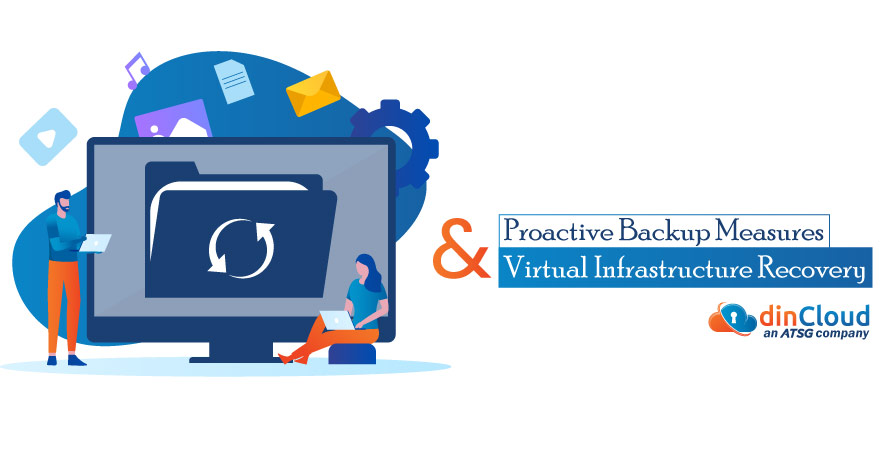An enormous amount of crucial, confidential and sensitive data is available on the internet. It is vital that we must protect it from theft, cyber attacks or loss due to hardware failures. If enterprises adopt a laid-back and reactive approach towards this problem, later, they would have to pay the price. Astute IT leaders will have a proactive approach towards this problem. They must preempt this problem, and put preventive backups in place to minimize the impact of corruption of data.
Software-based data restoration options are available on Virtual Infrastructures now. Collection of data, backup creation and storage of Virtual Machine VM with Operating Systems can be done, all at the same time.
Network congestion can be eradicated by configuring the backups offerings with VM storage locations. This greatly reduces the time period required for backup process of virtual infrastructure.

Since VM, as a single file set, is available for backup, the restoration of one specific file becomes tough. However, many applications have file retrieving feature from Virtual Machines in stored backup.
Related: Understanding Fault Tolerance in Cloud Computing Environments
Data Restoration and Backup Gaining Popularity
Strong and secure proactive data restoration options must be setup to prepare for worst case scenarios. The better option, however, is that organizations put in place highly secure storage setup, beforehand, to safeguard and protect data against malware, ransomware, natural disasters etc.
Sometimes, due to unforeseen circumstances, even with everything kept intact, data accidentally gets lost. The wide range of backup and recovery options that are now offered by Cloud Service Providers, do provide the option of software backup. This will help the Virtual Machines (VMs) to be restored to their original states.
Software stakeholders must contact Virtual Infrastructure Admins in order to come up with a backup strategy or discuss the already prevalent backup strategy of their VM providers.
Another key feature for backup is when, in advance, an application is informed that backup is about to take place. This feature allows applications to have quiesce mode on, letting it flush pending input and output operations to the disk. This is called application-consistent feature. This technique greatly improves the consistency and integrity of data backups, regardless of their frequency.
Another thing to consider is that, if machines have data dependencies, restoring one of them from the set, can make the all other files corrupt as well. This is another risk that needs to be given due consideration when designing a robust backup strategy.
Backup software feature is used to save an application-consistent backup checkpoint and quiesce the application at the time backup is being made. Some of the files, within the system, are constantly running in the backend so its important to quiesce the business application at the time of backup. Once everything is complete, the saved data is placed back into production.
Related: How are Cloud Computing and AI Putting Out Wildfires?
Continuous Data Protection – CDP
In Continuous Data Protection CDP, all the copies of data are automatically saved. This includes every single change made on that data. Backup software usually contains copy of data stored in them, when it is updated by an admin during the production stage. At this point, admin can go back to any specific time period for restoration of data. Software performance, in regards to the backup, will be responsible for determining whether or not, some amount of data will be lost at this stage.
Production storage is massive, and hardware should be at equivalence level with this storage, consequently making it more expensive. This is an ongoing challenge with CDP that writes from production must match backup offers.
Cloud Service Providers (CSP) that make CDP installation, can make the VM restoration process fast, incorporating a mechanism for replication. They can keep updating the replicated VM, and as soon as there is a problem or loss of VM, the replicated one will quickly be put into production. So, to sum it all up, the speed of VM restoration, amongst other things, depends on how an enterprise implements Continuous Data Protection feature.
Related: How to Streamline Business Processes by Leveraging Cloud Solutions?
Backup copies are retained offline as well, so that the IT persons can help recover Virtual Machines in case the data is lost. With CDP, the restoration of offline data is a slower process, but it is still way better than not getting to restore any data at all.
Conclusion
Organizations use both, Continuous Data Protection and Backups, to restore their data. Backups restore data faster as compared to CDP. CDP, on the other hand, recovers each and every piece of data but with production lags.
Considering the agility and easy to use nature of the Public Cloud, the transformation to digital is in full swing. An increasing number of enterprises want their Cloud Service Providers to up their game in terms of scale, capability and backup/restoration solutions.
A reliable Cloud Service Provider, like dinCloud, an ATSG company, offers powerful disaster recovery solutions to ensure continuous protection of data. dinCloud’s Virtual Machines VM offer superior security, built right at the center of the infrastructure. They provide improved usability and enhanced security for remote-based users.


